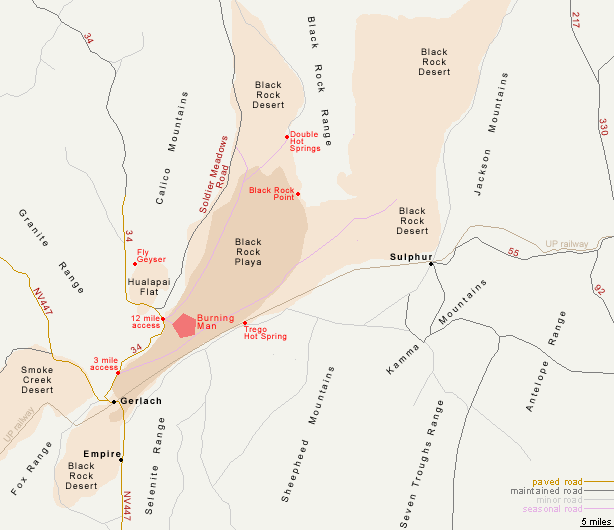Geothermal Activity and Fly Geyser
In the Black Rock Desert, there is a network of fault lines that contribute to the geothermal activity seen on the surface and edge of the playa. The fault lines occur around the edge of the basin, near the bottom of the mountain ranges, like that of Granite Range, that surround the playa and are the location of the geyser and hot spring activity. The particular type of fault seen here, known as a thrust fault, is a result of the compression of the upthrown block on top of the downthrown block of earth at a low angle. This is the reason we can see mountain ridges around a fairly flat surface such as the Black Rock Desert playa.

On this map, Fly Geyser, Double Hot Springs and Trego Hot springs are located at the edge of Black Rock Playa, which is the part of the desert basin that was once the bottom of the lake bed of the ancient Lake Lohontan.
Map credit www.americansouthwest.net
Located on the western edge of the Black Rock Desert is Fly
Geyser. This is an example of the
geothermal resources that Black Rock Desert has available. The man made geyser sits on private property
and was made by accident in 1916. A well was being drilled in hopes to make use
of the water for irrigating the dry land.
As the well was being drilled, a, geothermal source of water was
penetrated. The water that came up was nearly
200 degrees, unusable for farming. A second attempt to drill a well also failed and abandoned at the site in the 1960's. The
water ejected from the geyser is rich in minerals, such as calcium carbonate, and has formed a cone shape around the original well pipe. Over time, these deposits have progressed from
small cone shaped deposits around the geyser opening, to bulbous and vividly
colored formations, the water in constant flow from the geyser. The thermophilic algae that grows on the mineral deposits thrives on the mineral deposits and create the unusual red and green colors that develop over the surface.
In this photo, the geyser flows through the mineral deposit
formed cones, which are made the bright colors by heat resistant microorganisms
called thermophilic algae that inhabit the surface. Photo credit explore-mag.com
Sources
ftp://ftp.nbmg.unr.edu/pub/.../11.../Schaefer_OFR-81-918.pdf
ftp://ftp.nbmg.unr.edu/pub/.../11.../Schaefer_OFR-81-918.pdf
atlasobscura.com/places/fly-ranch-geyser
http://en.wikipedia.org/wiki/Fly_Geyser